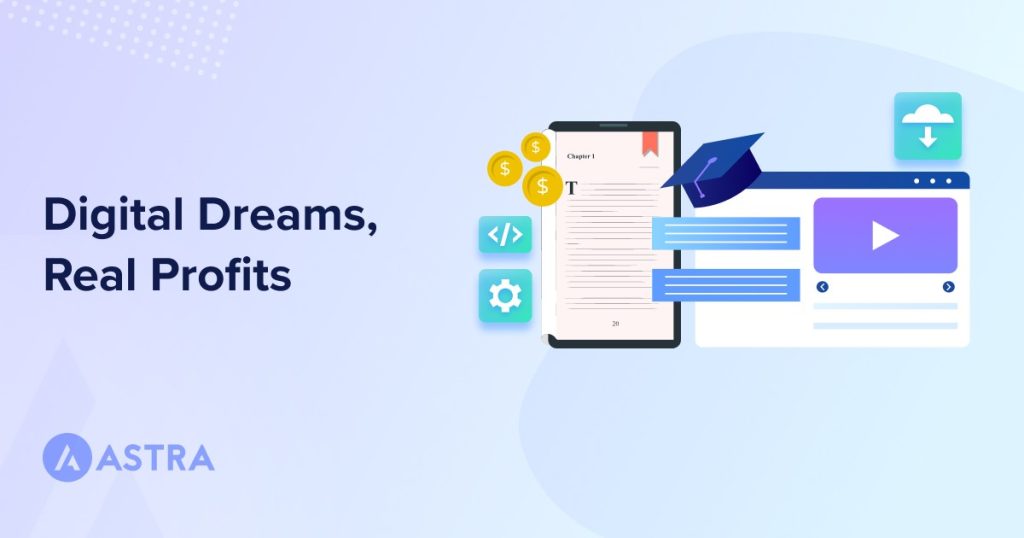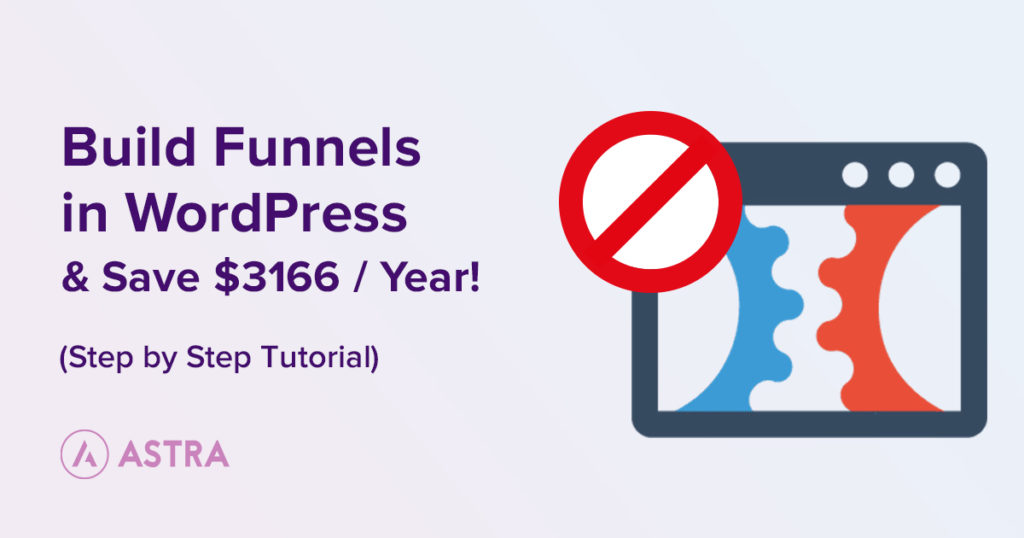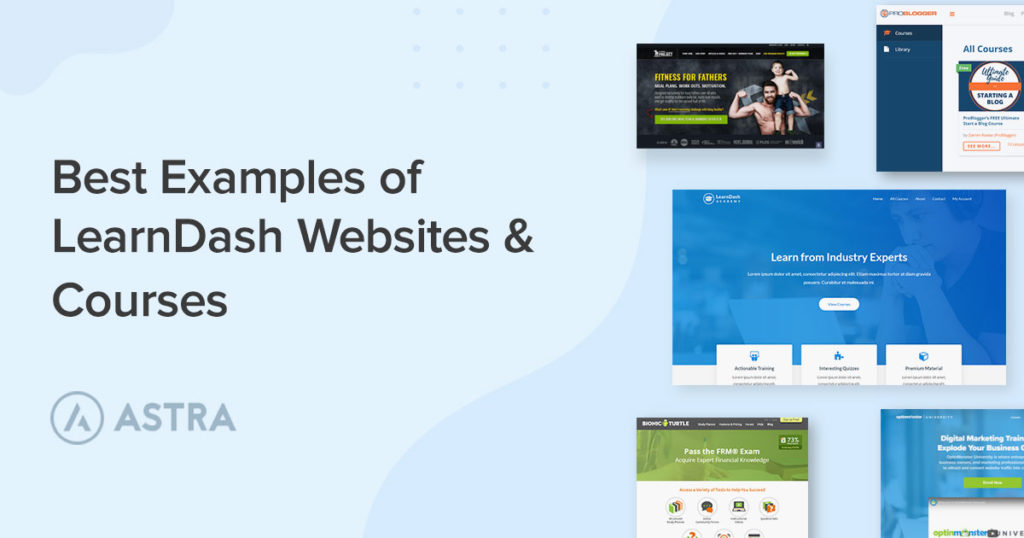Are you on the lookout for the best digital products to sell in 2025?
For many, it’s a worthwhile venture.
Just look at what Think Media Podcast was able to accomplish. They made $546,586 just by selling a $27 digital product.
Selling digital products is a highly effective strategy to monetize your online presence.
It offers flexibility and the potential for high profit, especially when combined with other revenue streams like display ads and affiliate marketing.
In this article, we will explore:
- Unique and profitable digital products: The goal is to provide you with innovative ideas that aren’t just different, but also have a strong market demand.
- Pros and cons of selling digital products: As we create digital products ourselves, we are well aware of the ups and downs of the business. We’ll share the inside story.
- The best platforms for selling them: We’ll give you a head start on what platform to use to sell your digital products.
First, let’s take a look at the digital products we’ll be discussing and evaluate them based on how hard they are to create and what their earning potential is.
Top 10 Digital Products and Their Earning Potential
| Product | Difficulty | Earning Potential | Notes |
|---|---|---|---|
| Online courses | Moderately difficult | High | – Depends on the niche – $60,200/year on average on Udemy – $1,200/month on Thinkific |
| Ebooks | Variable | Good | – Popular on platforms like Amazon Kindle – Earning potential of over $1000/month |
| Printables | Easy | Good | – Includes calendars, planners, worksheets – Earnings depend on niche – $100 – $1000/week |
| Membership sites | Moderately difficult | High (Steady income) | – Offers exclusive content – Provides steady income once established – Average membership fee is $25-49/month – Established sites earn $200-$5000/month. |
| Stock photos and videos | Medium | High (Consistent demand) | – $0.02 to $0.25 per image per month – Royalty-free sales between $0.10 and $99.50/month |
| Software and apps | Challenging | Very High | – Requires significant technical skills – Lucrative in niche markets – No guarantees of success |
| Digital templates | Moderately easy | Good | – Includes email templates, logos, business cards, and WordPress themes – Priced at $5 up to $200 |
| AI prompts | Medium | Promising | – Profit potential varies widely – Limited data available Most prompts sold start at $1.99 on PromptBase. |
| Graphic design assets | Medium | Good | – Textures, clipart, presets, and icons – Top sellers on Creative Market make $100,000+/year. |
| Fonts | Medium | Strong (Especially for unique designs) | – Time-consuming – Requires skill – Strong demand for unique fonts – Sell for $9 to $129 each on Fontspring. |
27 Digital Products To Sell
When it comes to digital products, the scope is massive and varied.
Each type of product offers unique opportunities for creators and entrepreneurs to monetize their expertise and passion.
In this section, we’re going to dive into specific digital product ideas, focusing on different personas to help you find the best fit for your skills and interests.
Here’s what we’ll be covering today:
- Digital products to sell for writers
- Ebooks
- Courses
- Community access
- Planners or journals
- Tutorials or guides
- Writing resources (grammar tools, spell-checkers)
- SEO tools
- AI prompts
- Digital products to sell for designers
- Digital planners
- Logo templates
- Business card templates
- Social media templates
- Design assets
- Fonts
- Design checklists or guides
- Digital products to sell for developers
- Website templates or themes
- WordPress plugins
- Niche apps
- Code snippets
- Digital products to sell for businesses
- Podcasts
- How-to guides
- Cheat sheets or checklists
- Financial or expense trackers
- Printable calendars
- Membership sites
- Subscription-based newsletters
- Notion templates
Digital Products To Sell for Writers
Selling digital products for writers is a solid way to earn income online.
There are many types of products you can offer – whether you’re a writer yourself, aim to help writers, or both!
1. Ebooks
Ebooks are not just a fantastic way to share knowledge and expertise, they’re also a smart way to earn some decent passive income.
The beauty of an ebook is that it can continue to bring in cash without much extra effort.
This especially applies to non-fiction like guides or how-to’s. Once you’ve done the heavy lifting of writing it, it can continue to earn for you.
You can sell them in many different ways. For instance, you can sell them on your own online store or membership site. Or, you can offer them on an external site like Amazon Kindle Direct Publishing (KDP).
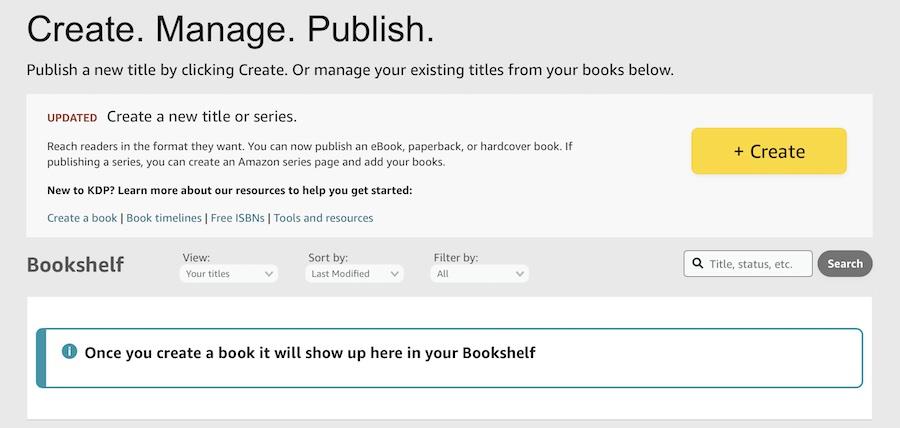
2. Online Courses
As a writer, creating and selling online courses can be a lucrative way to leverage your expertise.
The projected growth of the global eLearning market will reach over $370 billion by 2026.
Creating online courses can be a profitable venture!
Whether you’re a fiction author, a blogger, a content writer, or a self-help guru, there’s potential to develop courses that resonate with your audience.
- For fiction authors: Create courses on crafting compelling narratives, character development, or specific genre writing like mystery, sci-fi, or romance. You could include modules on plot structure, building suspense, or world-building.
- For bloggers and content writers: Courses on effective blogging strategies, content marketing, SEO, and social media engagement would be highly valuable. You can share insights on creating engaging content, driving traffic, and monetizing blogs.
- For educational writers: If your focus is on educational content, consider creating courses on specific subjects you’re knowledgeable about. This could range from history to science, language arts, or even professional skills like public speaking or writing.
- For business owners: You might consider creating courses that focus on your unique business insights and expertise. This could include things like developing successful business strategies, effective management and leadership skills, financial planning and budgeting, or niche-specific topics like industry trends.
A great example comes from SkillJet. It offers an in-depth course library covering topics like how to speed up a website and how to build recurring revenue.

Creating a course is a great way for a writer with some business knowledge to tap into that market.
When creating your course, focus on delivering quality content that’s engaging, informative, and provides real value.
Use a mix of video lectures, written materials, and interactive elements like quizzes or assignments.
3. Community Access
Creating and selling community access as a digital product can be a rewarding option.
Online communities provide a platform for sharing ideas, receiving feedback, and building connections.
Here are some insights into how successful online communities operate:
Pick a Single Focus Area
Communities like Author Ever After offer a way for people to connect over a topic they’re passionate about with a specific focus – in this case learning how to become a published romance author.

Those interested can sign up for a fee and gain access to a community, mentoring, and other perks.
Critique and Feedback Platforms
Communities like Critique Circle offer structured environments where writers can receive constructive feedback on their manuscripts from fellow writers.

This model can be helpful for those looking to improve their skills and manuscripts before publication.
When considering setting up an online community as a digital product, focus on identifying the unique needs of your target audience and how you can provide value through your platform.
Offering a mix of educational content, networking opportunities, and personalized support can make your community more appealing.
4. Planners or Journals
For those looking to create and sell digital planners or journals, there’s a variety of approaches to consider.
- Business and productivity planners: Designed for entrepreneurs, business professionals, or anyone looking to boost their productivity. They might include sections for goal setting, financial tracking, project management, or meeting agendas. Think of planners that help track business growth, manage client projects, or even organize daily tasks.
- Marketing and content planners: Ideal for digital marketers, content creators, or social media managers. Planners can focus on strategy planning, content scheduling, campaign tracking, and analytics review.
- Financial planners: Aimed at individuals or professionals managing finances, these could include budget planners, expense trackers, investment logs, or savings goals.
- Educational and student planners: Can be tailored for students or educators. Can include sections for lesson plans, assignment tracking, study schedules, or academic goal setting.
- Health and wellness journals: Focused on personal well-being. Journals can include meal planners, workout logs, mental health trackers, or meditation and mindfulness prompts.
- Household and chore charts: Great for organizing household tasks. Planners can include chore schedules, meal planning, shopping lists, or maintenance logs. They’re helpful for anyone looking to streamline household management.
- Hobby or Interest-specific journals: Whether it’s gardening, cooking, or DIY projects, these journals can be tailored to specific hobbies or interests. They might include project logs, recipe collections, or tips and techniques related to the hobby.
- Travel planners: For those bitten by the travel bug, these planners can include itineraries, packing lists, budget trackers, or travel journals. They’re perfect for planning trips, whether for business or leisure. They might even serve well as a lead generation item for travel blogs.
- Personal development journals: Can include goal-setting guides, self-reflection prompts, habit trackers, or gratitude logs.
You can find countless examples of planners on Etsy because the revenue potential is pretty high.
Take the Etsy shop, Prosperous Printables as an example:
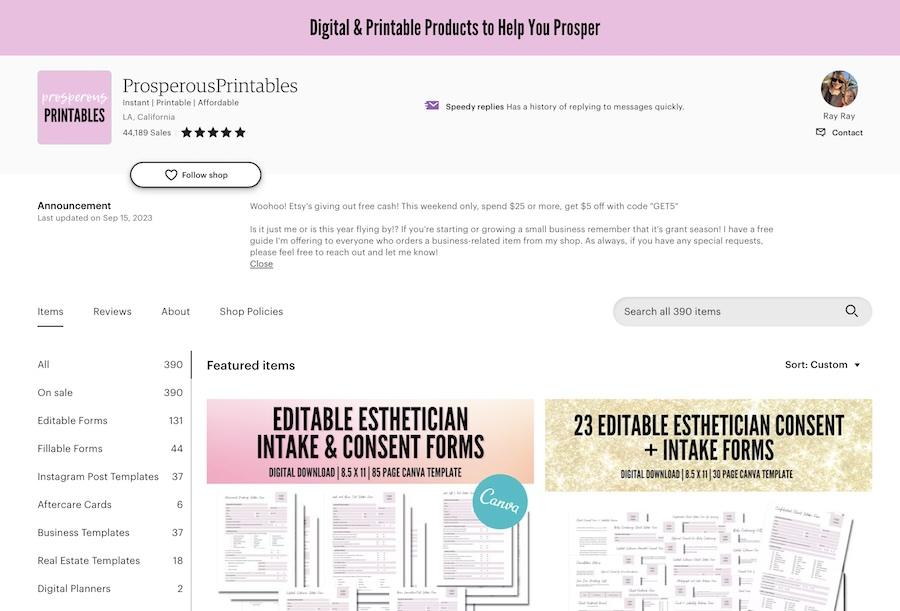
This store has made 44,189 sales since 2019, with items averaging around $5/each.
That’s around $45,000 per year, with much of this income being passive once the initial planner is created.
5. Tutorials and Guides
Creating tutorials or guides offers a valuable avenue to share your expertise.
If you’re well versed in a specific subject, you can craft guides offering insights and strategies unique to those topics and put your writing skills to work.
For writers skilled in technical, business, or academic writing, producing guides can be highly beneficial.
Consider developing process-focused tutorials that offer step-by-step instruction on a complex subject. Or illustrated guides that could be offered as downloadables.
Even one or two-page guides sold for $1 on your own website could be a great way to develop a passive side income.
6. Writing Resources
Offering writing resources such as grammar tools and spell checkers can be a valuable service for other writers.
For instance, you could create grammar and style checkers.
These tools focus on improving writing quality by checking and correcting grammar, punctuation, and style.
Think Grammarly and you’re on the right track.

There’s a broad market for this type of product. It ranges from students to professionals, all needing to improve their writing.
Or, you could create reference tools.
Compile and offer comprehensive guides or databases on specific writing topics. Think idiomatic expressions, synonyms and antonyms, or industry-specific terminology.
All things the average person can have difficulty with.
Templates are a big hit, too.
Provide templates for different writing projects, like press releases, blog posts, or screenplays, to help writers get started and structure their work.
7. SEO Tools
SEO tools are designed to boost a website’s ranking in search engines. They provide insights into keyword effectiveness, backlink analysis, and website performance.
As a writer, you understand the importance of keywords and how they shape content. This understanding is invaluable when creating SEO tools.
Your role in this space would be multifaceted. You could develop user-friendly guides and tutorials explaining how to use them.
Or, you might team up with developers to create your own tool from scratch.
There are several out there already but you could potentially find an angle that or approach that brings something fresh to the space.
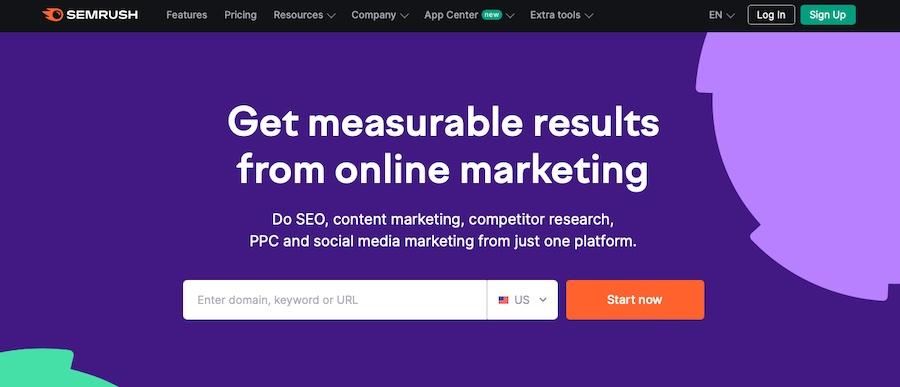
Popular examples include Semrush, Ahrefs, and Moz.
8. AI Prompts
Let’s talk about AI prompts. It’s a niche that’s suited for writers with a flair for creativity and a grasp of how language works.
AI prompts are inputs used to guide AI in content creation or response generation. Here, your writing skills can be used to craft prompts that get the AI to make the desired output.
A well-written prompt can make all the difference and is actually pretty difficult to write.
If you can use your skills to create nuanced prompts that can direct AI to produce desired outcomes, that’s something you could monetize.
You could create and sell packages of prompts for different applications, such as storytelling, content writing, or customer service chatbots.
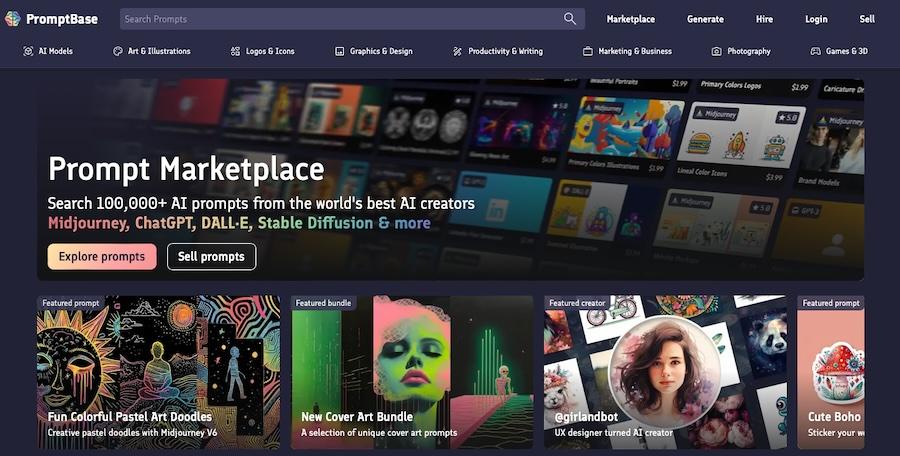
There’s a burgeoning market worth exploring here. For instance, PromptBase is an AI prompt marketplace where people can create and sell prompts.
If you want to go your own way, create a website in under five minutes with ZipWP!
Digital Products To Sell for Designers
For designers looking to venture into the eCommerce market, there’s a unique opportunity to create and sell digital products.
After all, you have the design skills to put to work here.
9. Digital Planners
This approach taps into the growing demand for organizational tools in the digital space. They can cater not just to fellow designers, but also to business owners and other professionals.
We’ve already discussed these in-depth above but it’s worth mentioning that designers can leverage their skills to create these as well.
The beauty of digital planners lies in their versatility and appeal to a wide audience.
For instance, a planner designed for other designers might include elements like color palettes, font libraries, and space for sketching out ideas.
On the other hand, a planner for business owners might focus on financial tracking, project milestones, and meeting schedules.
You can find countless examples of planners being sold in this manner on Etsy. Take this Watercolor Digital Planner as an example:
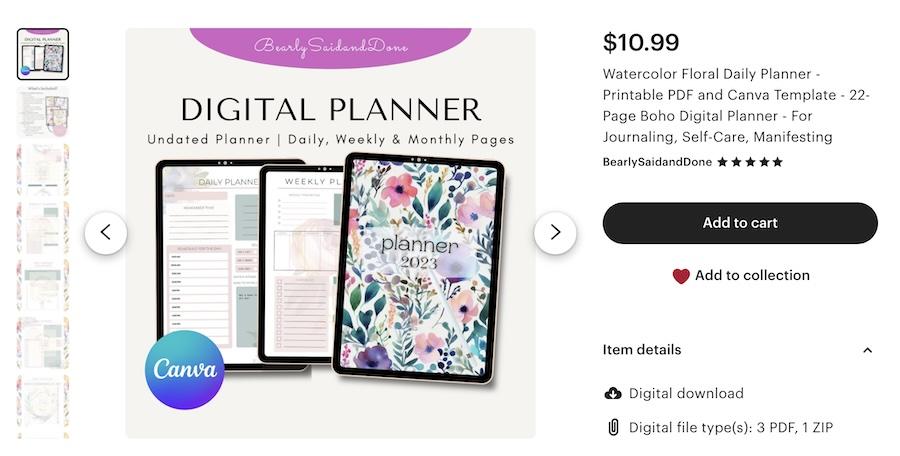
It’s undated and can easily be printed for use or can be customized with a graphics tool like Canva.
10. Logo Templates
Selling logo templates is a smart move for designers looking to tap into a profitable niche.
It’s a straightforward concept: create a range of customizable logo templates that cater to different business needs.
Think about the variety of businesses out there. From sleek tech startups needing something modern and minimalistic, to artisan cafés looking for something more quirky and vintage.
Your templates can be that go-to resource for these varied needs.
Platforms like Envato Market are perfect examples of where designers can showcase and sell their logo templates.

On Envato, you’ll find a huge audience of business owners and entrepreneurs browsing for that perfect, yet affordable, branding element.
The trick is to make your templates easy to tweak, so someone with minimal design experience can make them their own.
11. Business Card Templates
Selling business card templates is another digital product possibility for designers to explore.
This digital product caters to professionals and businesses of all sizes looking for easy-to-customize, yet professional-looking business card designs.
Many people are earning a living by selling business card templates that customers can modify on their own using drag-and-drop software.
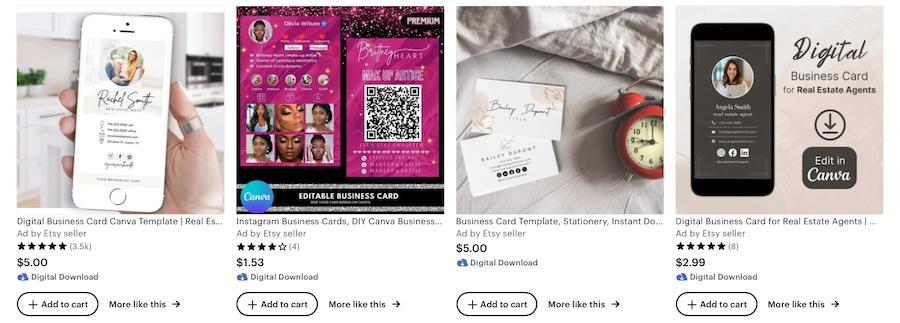
12. Social Media Templates
Another option is to create a diverse range of templates tailored for various social media platforms, like Instagram, Facebook, X, and LinkedIn.
The designs could include post layouts, story backgrounds, cover photos, and profile images.
The goal is to craft templates that are visually appealing and user-friendly, allowing clients to easily customize them with their content.
You will need to stay updated with trends in social media design and understand the specific requirements of each platform though.
They all have different sizing specs you’ll need to know.
Take Luna Studio as an example. This designer offers fine art prints on their personal website but also sells social media graphics and graphics bundles on Creative Market:

If you decide to take this approach, you’ll need to provide a mix of modern, flexible, and easy-to-edit templates.
Over time, this can position you as someone who meets the demand for high-quality, ready-to-use social media graphics.
13. Design Assets
Design assets include a wide range of products like icons, textures, and illustrations.
When creating design assets, consider what could be in high demand.
For example, unique icon collections can be a hit, especially if they cater to specific branding styles or trends.
Similarly, custom illustrations can be sought after by app developers or website designers looking for that unique touch.
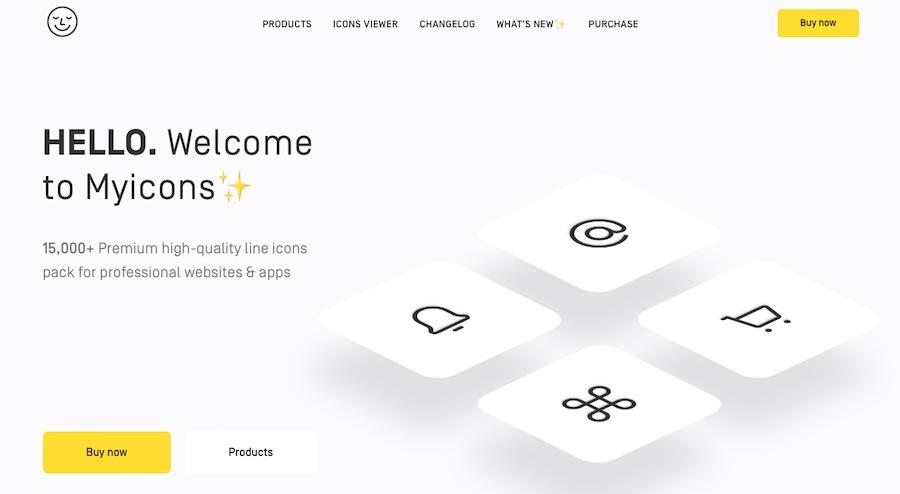
Myicons offers a great example of someone selling digital assets. They provide a bulk deal of over 15,000 icons, which makes it stand out in an otherwise crowded marketplace.
14. Fonts
Selling fonts is an excellent niche for designers. Unique and expressive typography is highly sought after right now.
Since fonts play a key role in branding, web design, and digital content creation, they’re an equally valuable digital product to sell.
When creating fonts, think about the diverse ways they may be used.
From corporate branding needing sleek and professional typefaces, to creative projects looking for more whimsical or artistic fonts.
The key is to design fonts that are not only visually appealing but also functional across different mediums, such as web, print, and mobile.
Platforms like MyFonts and Fontspring are ideal for selling your font creations.
They cater to a wide audience, from graphic designers and marketing professionals to independent creators.
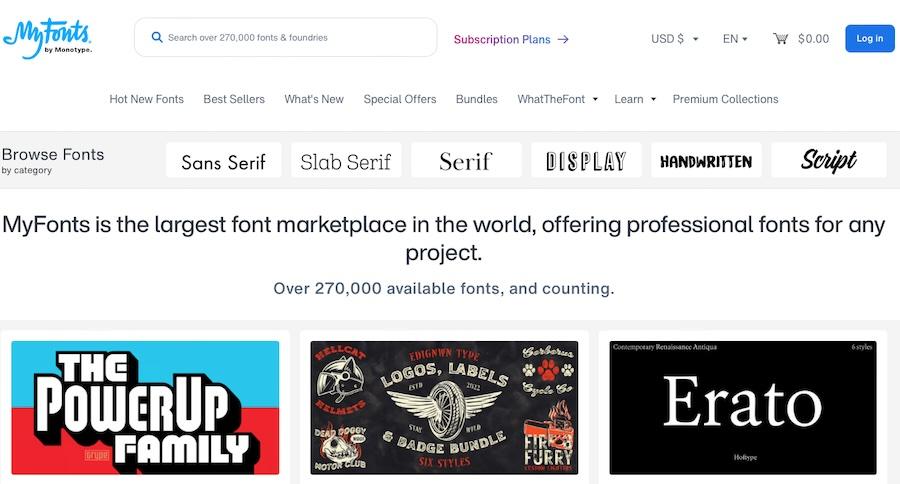
These platforms also offer the necessary exposure and credibility that can help your fonts reach a broader customer base.
15. Design Checklists or Guides
Checklists or guides can be a great choice for designers at all levels to sell.
They can provide structured advice, best practices, and step-by-step processes for various design projects – or any topic, really.
If targeting fellow designers with your products, consider the different challenges designers face, from brainstorming and conceptualizing to executing and finalizing a project.
Your content could range from basic design principles for beginners to more advanced techniques for experienced designers.
Topics might include UI/UX design checklists, website launch checklists, brand identity guidelines, or tips on color theory and typography.
Platforms like Gumroad or Etsy are great for selling these types of digital products.
A great example is this design guide, Beyond UX Design.
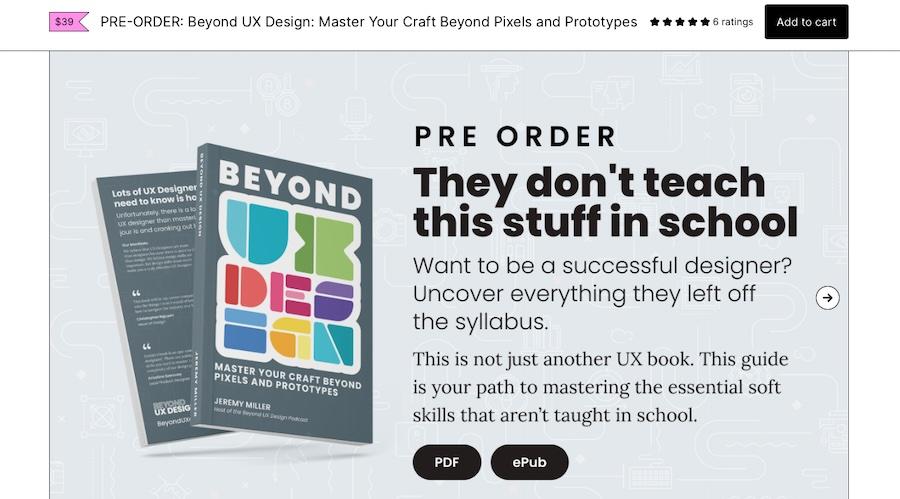
Digital Products To Sell for Developers
Developers looking to dive into the digital product market, have some exciting possibilities to explore.
16. Website Templates or Themes
Think about the countless individuals and businesses out there needing a slick website without the high cost of custom design.
You could create website templates or themes that are not just good-looking, but also user-friendly and adaptable.
Whether it’s for WordPress, Shopify, or Squarespace, your templates could be the go-to solution for anyone from bloggers to online store owners.
Not to brag, but we offer a firsthand example of how successful this digital product type can be:
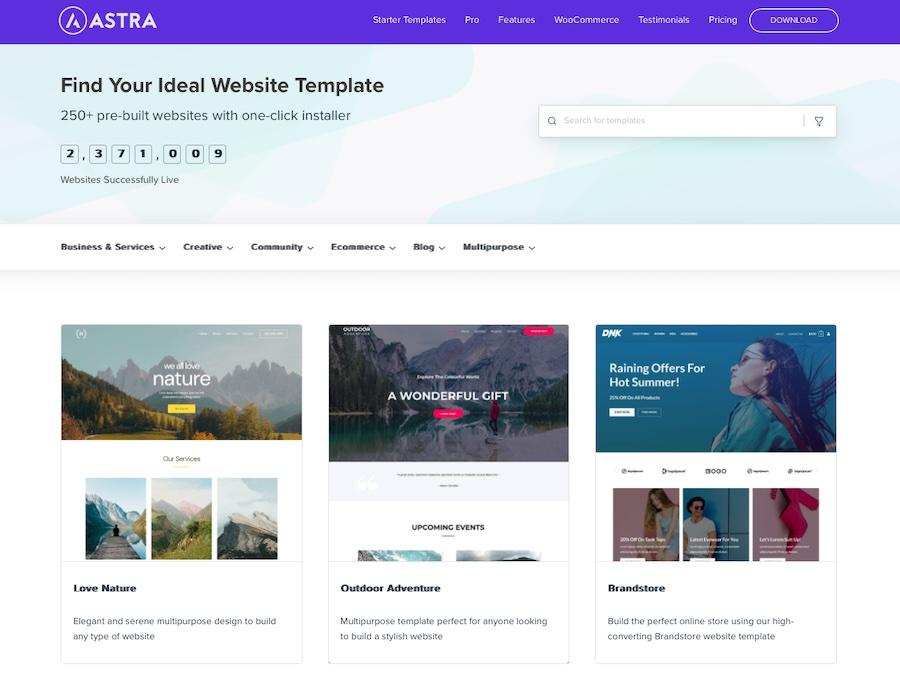
The Astra WordPress theme has been downloaded over 2 million times so we know what we’re talking about!
17. WordPress Plugins
There’s a huge demand for WordPress plugins that solve specific problems or add new features to websites.
You could develop a plugin that boosts a site’s SEO, makes social media sharing a breeze, or ramps up website security.
SureCart offers a great example of how you can sell a plugin on your own website and be wildly successful.
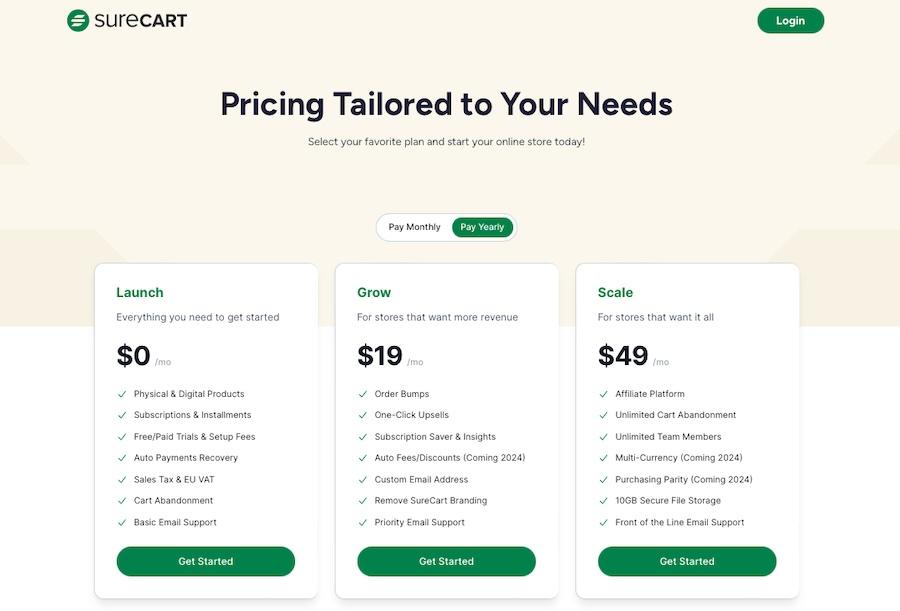
Once you’ve created a plugin, you can sell it on marketplaces like CodeCanyon or on your own website.
18. Niche Apps
Got an idea for an app that targets a specific interest or need? This could be a gold mine!
Niche apps – think along the lines of a unique fitness tracker, a specialized recipe app, or a project management tool – can really resonate with a specific audience.
The key here is to find a need that’s not being met by current apps and fill that gap with your creation.
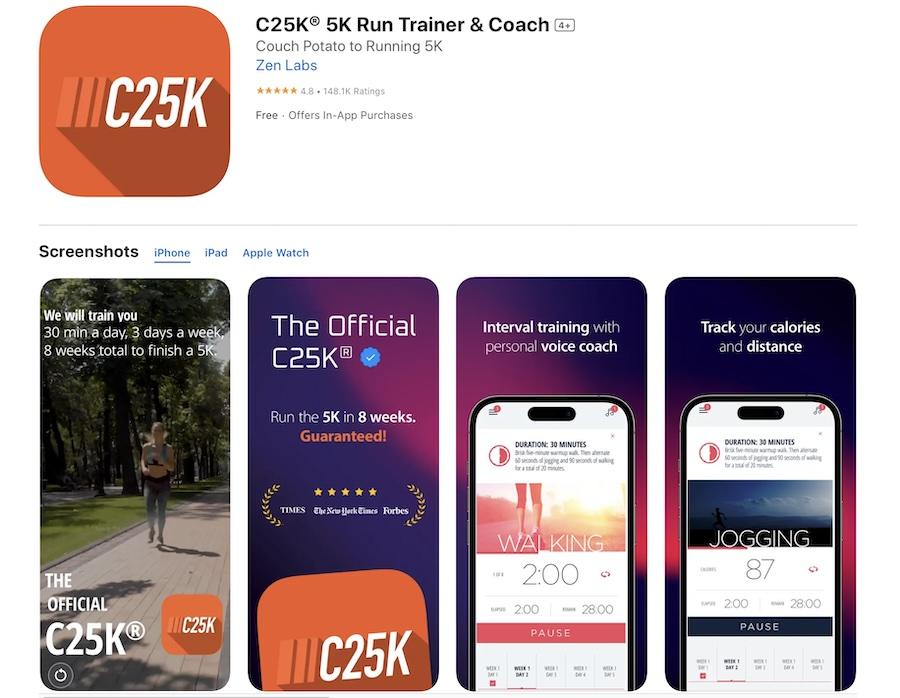
For example, the C25K 5K Run Trainer & Coach app, that helps people improve their running abilities. While the app is free, it offers in-app purchases.
If you want to sell software on your own website, how you offer it matters a lot.
According to entrepreneur Mohamed Issa on Quora, “…the subscription model offers better revenue potential than licensing,” noting that “[i]f you sell licenses, you get paid just once,” which is definitely something worth considering.
19. Code Snippets
For developers who want to help others streamline their code, selling code snippets is a brilliant idea.
Whether it’s a neat CSS styling shortcut, a handy JavaScript function, or a mini-library for common coding tasks, your snippets could save fellow developers loads of time and hassle.
Digital Products To Sell for Businesses
Business owners can also take advantage of the digital product market.
There are tons of opportunities to create and sell tools that can enhance productivity, organization, and knowledge in various industries.
20. Podcasts
Starting a podcast can be a game-changer for businesses looking to establish thought leadership and connect with their audience on a more personal level.
Businesses can delve into topics relevant to their industry, interview experts, or share insights that can help listeners grow professionally.
The trick here is to provide value through engaging and informative content that appeals to your target audience.
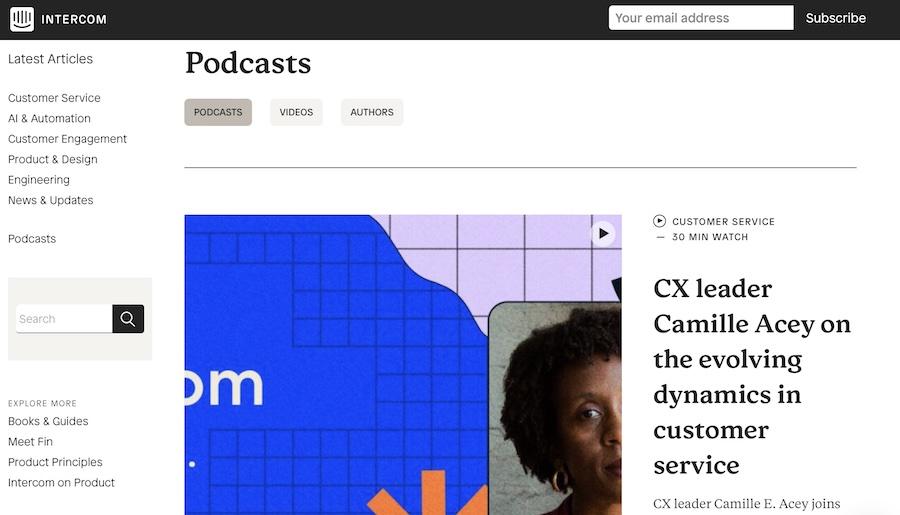
For instance, Intercom started its own podcast called Inside Intercom where they interview all sorts of experts on business topics.
21. How-to Guides
Businesses can create and sell comprehensive how-to guides on specific topics related to their industry.
These guides can be invaluable resources, offering step-by-step instructions, best practices, and expert tips.
For example, a digital marketing firm could sell guides on executing successful social media campaigns or SEO strategies.
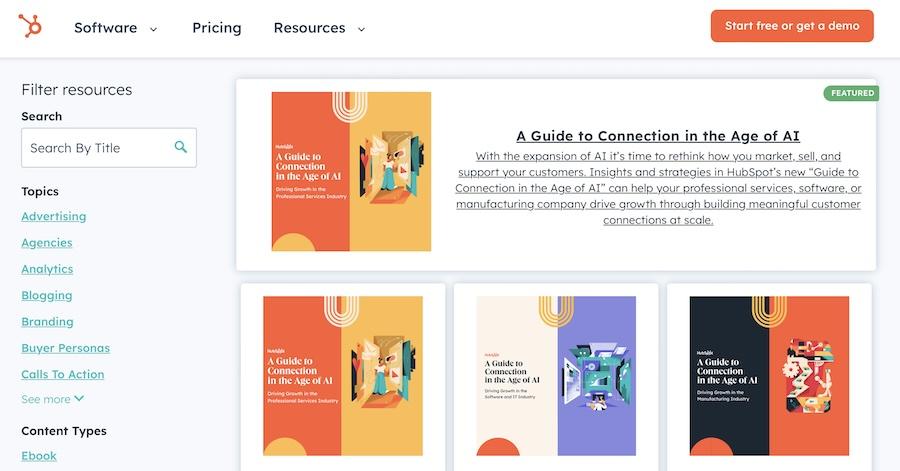
HubSpot offers a great selection of guides and tutorials. They offer them for free but use them as a part of their lead generation strategy.
22. Cheat Sheets or Checklists
Cheat sheets or checklists are simple yet effective digital products for businesses.
They can offer quick references on various topics, like project management steps, sales strategies, or daily operational checklists.
They are great for helping other professionals streamline processes and ensure they’re covering all necessary steps.
You can find tons of examples online, like this business startup checklist:

23. Financial or Expense Trackers
Financial or expense trackers are practical tools for small businesses and freelancers. These can be spreadsheets or apps designed to help track income, expenses, and budgeting.
Tailoring these trackers to specific business needs or industries can make them highly appealing and useful.
For instance, you could create a finance tracker like this one on Gumroad:
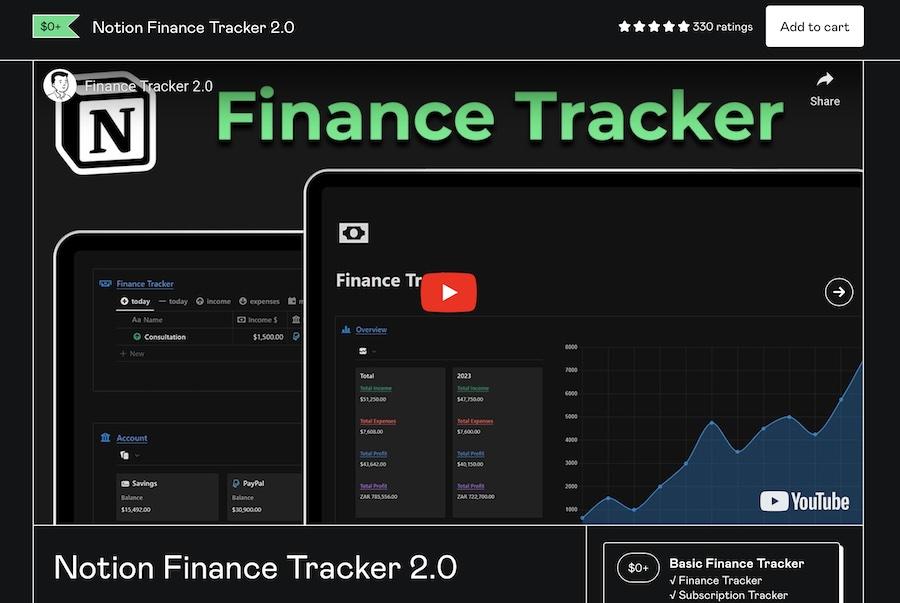
24. Printable Calendars
Printable calendars, customized for specific business needs, can be a simple but effective product, too.
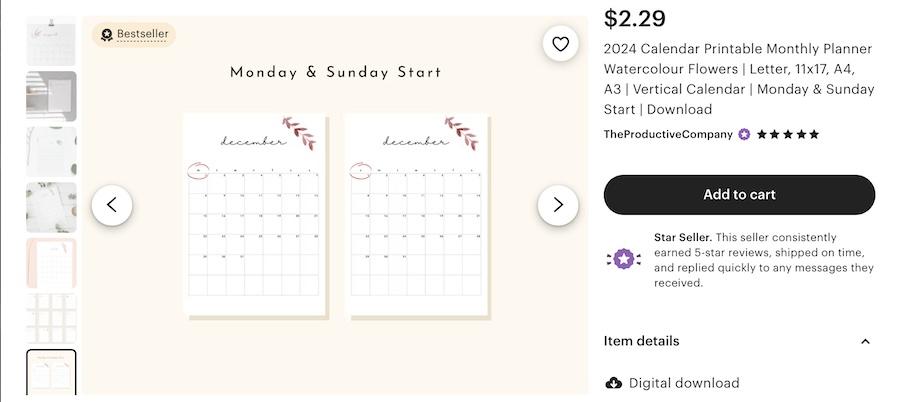
These offerings can range from editorial calendars for content planning to project timelines, offering a visual tool for planning and organization.
25. Membership Sites
Creating a membership site can be a lucrative model for businesses. You can offer exclusive content, resources, or services, like specialized training, webinars, or industry reports.
The key is to provide enough value that customers feel the subscription is a worthwhile investment.
But if you have the content to back it up, building a membership site is a great idea.
Should you decide to build on WordPress, you can easily use the SureMembers plugin to streamline your efforts.
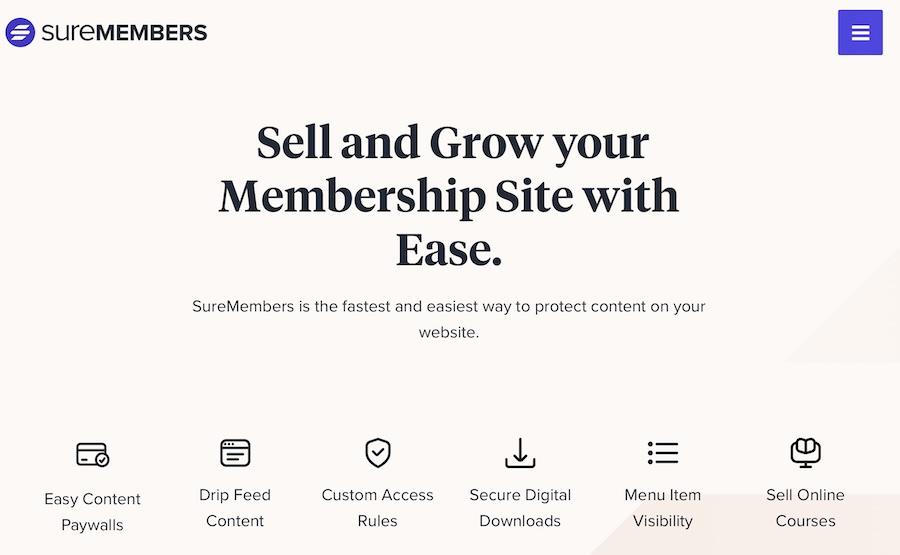
26. Subscription-based Newsletters
Launching a subscription-based newsletter allows businesses to regularly share industry insights, trends, and tips directly to their audience’s inbox.
This can be a powerful tool for building and maintaining customer relationships and establishing authority in your field.
A popular way people monetize their newsletters is through Substack. There are countless successful examples of this, but here’s one with current posts, Changing the Channel:

27. Notion Templates
With the rising popularity of Notion as an organizational tool, businesses can create and sell custom Notion templates.
These templates can be designed for various business functions such as project management, content planning, or CRM, offering people a ready-made solution to organize their workflows.
Here’s a particularly impressive one called Life OS Dashboard that features plenty of organized sections and even animated headers:

Advantages of Selling Digital Products
Selling digital products offers a range of benefits that are quite appealing.
Let’s take a look at them now:
Lower Overhead Costs
One of the biggest perks of selling digital products is the significantly lower overhead costs.
According to C3Everything on a Reddit thread for Etsy sellers, “It takes zero money to start making digital goods, and very little to sell them.”
You bypass many of the expenses associated with physical products, like manufacturing and storage.
Plus, once your digital product is created, it can be sold over and over again without extra costs.
That makes the process much more cost-effective and efficient!
Passive Income Potential
Digital products offer a sustainable form of passive income.
After the initial effort of creating the product, there’s less ongoing work to maintain sales compared to physical products.
This means you can continue to earn revenue over time without putting in constant effort.
Scalability
The scalability of digital products is a major advantage.
There’s no worry about restocking inventory or expanding physical space.
You can sell an unlimited number of copies, allowing your business to grow without the traditional limitations.
Global Market Access
When you sell digital products, the entire world becomes your marketplace.
You’re not restricted to a physical location. Anyone with internet access can potentially be a customer.
This dramatically increases your potential customer base and sales opportunities.
Flexibility and Lifestyle
Selling digital products often means you can work from anywhere, giving you a great deal of flexibility.
Whether it’s from home, a coffee shop, or while traveling, this model offers an ideal work/life balance and adaptability.
Direct Customer Communication
With digital products, you have unique ways to communicate directly with your customers.
You can build communities, offer exclusive access through various channels, and maintain ongoing relationships.
All things that can lead to more sales.
Creative Control and Brand Building
Selling digital products gives you total creative control.
They represent your brand and expertise, allowing you to carve out a future path that aligns with your vision and goals.
It’s a chance to build your brand exactly how you want it, and make a name for yourself within a given niche without huge upfront costs.
Disadvantages of Selling Digital Products
Of course, there are some challenges associated with selling digital products.
Competition
One of the main challenges when selling digital products is the intense competition. The online market is vast, and you’re up against sellers from all over the world.
Standing out and making your products noticeable amidst a sea of options can be daunting and requires a strategic approach.
Risk of Piracy
Digital products are susceptible to piracy, as they can be easily copied and distributed without permission.
Though not necessarily as big of a risk to software developers or those creating copyrightable works, this is something guide, template, and printable creators should be mindful of.
Building Customer Trust
Creating trust with customers can be more challenging with digital products. Unlike physical goods, customers can’t physically examine digital products before purchasing.
Providing detailed product descriptions, previews, and exceptional customer service can help you to overcome this hurdle.
Value Perception Issues
Sometimes digital products are perceived as less valuable than their physical counterparts because customers can’t physically handle them.
It’s important to effectively communicate the value and benefits of your digital products to justify their price and encourage purchases.
Constant Need for Innovation
The digital product market is always changing, which means you need to keep with the times and innovate.
There is considerable effort involved with staying on top of industry trends, customer preferences, and the latest tech to ensure your products remain competitive and appealing.
Technical Challenges
Selling digital products involves navigating various technical aspects, from website maintenance to ensuring secure payment gateways.
Technical glitches or cybersecurity issues can significantly impact your business. They can require ongoing attention and possibly technical support.
Marketing and Visibility
Effectively marketing digital products is a must but another set of tasks besides making the products themselves.
Ensuring your products reach the right audience and stand out requires a well-thought-out marketing strategy and investment in advertising and promotion.
Where To Sell Digital Products
Deciding where to sell your digital products is as important as creating them.
You have two primary avenues to pursue here: selling on your own site or using third-party platforms.
Each has its advantages and caters to different business needs and strategies. Let’s quickly review both options.
Sell Digital Products on Your Own Website
Selling digital products on your own WordPress website gives you complete control over the process.
You can customize the look and feel of your site to match your brand, and you’re not bound by the rules and fees of third-party platforms.
A popular choice for building a WordPress site is, of course, the Astra theme with Starter Templates.

The Digital Product Store Starter Template is a great option to use for selling digital products.

This combination offers a wide range of design options and is user-friendly, even for those who aren’t tech-savvy.
For the actual selling part, SureCart is a powerful and flexible option for selling digital products.
It’s a WordPress plugin that allows for easy product listing, secure payment processing, and efficient order management.
If you plan to sell memberships, SureMembers integrates seamlessly with SureCart. They make it easy to sell subscription-based products or exclusive content.
Sell Digital Products on a Third-Party Platform
Alternatively, third-party platforms can provide a readymade audience and simplified selling processes.

They vary in their focus and features so it’s worth considering which aligns best with your product type and business goals.
| Platform | Top Features |
|---|---|
| Amazon | Wide audience reach, reliable payment processing, strong customer trust |
| Etsy | Ideal for creative and unique products, strong community, easy to set up a shop |
| Udemy | Excellent for educational content and courses, large user base interested in learning |
| Skillshare | Focuses on creative learning, good for video-based courses, community engagement |
| Gumroad | Simplified selling process, good for a variety of digital products, direct customer communication |
| Envato | Specializes in creative digital assets, high-quality standards, large creative community |
Each platform has its own set of benefits, from Amazon’s vast audience to Skillshare’s focus on creative education.
Consider factors like platform fees, audience type, and the kind of support and exposure you’ll receive when choosing where to sell your digital products.
How To Promote Digital Products
Promoting digital products effectively can make all the difference in turning your online sales efforts into successful revenue streams.
Here are some proven strategies to boost your digital product sales:
1. Create User-Friendly Sales Pages
Ensure your sales pages are easy to navigate and read.
Use bullet points to highlight product features, include eye-catching images and videos, and embed clear call to action (CTA) buttons for easy purchasing.
2. Promote Through Content
Use your existing content channels, like YouTube videos or Instagram Reels, to subtly promote your digital products.
Create content that aligns with your product, and integrate CTAs that direct your audience to your product.
3. Partner With Other Creators
Collaborate with other creators who have a similar yet slightly different audience.
Sponsored posts or affiliate programs are effective ways for these partnerships to expand your product’s reach.
4. Start an Affiliate Program
Create an affiliate program where bloggers, influencers, and marketers promote your product for a commission.
This extends your marketing reach and is cost-effective since you pay only for successful sales.
5. Engage in Online Communities
Promote your product in relevant online communities, like Facebook or LinkedIn groups and online forums.
Ensure your posts are natural and value-driven to build trust.
6. Use Email Marketing
If you have an email list, use it to promote your digital product. For new audiences, create lead magnets to entice sign-ups and nurture them towards purchase.
7. SEO Optimization
Optimize your website and content for search engines using relevant keywords. Include on-page, off-page, and technical SEO to improve visibility and drive organic traffic.
8. Use Social Media Platforms
Build an organic presence on social media platforms relevant to your target audience.
Consistently post educational or engaging content and interact with your followers to grow your base and promote your products.
You can integrate social media sharing into your website as well using WordPress social media plugins.
9. Create Tutorial Videos
If your product is software or a tool, create tutorial videos and post them on platforms like YouTube or TikTok.
This educates potential customers and showcases how your product can be used.
Sell Digital Products and Expand Your Earning Potential
Selling digital products offers a versatile way for creators across various fields to make money.
Whether you’re a writer, designer, developer, or business owner, selling digital products offers endless possibilities to monetize your skills and expertise.
For those looking to start selling digital products, our Digital Product Store Starter Template is a great option to pair with the Astra theme.
It’s a contemporary eCommerce design tailored to showcase digital products effectively. With its calm colors, simple design, and effective typography, this template is designed to convert visitors into customers.
Selling digital products is as much about the quality and relevance of your offerings as it is about effective marketing and finding the right platform to reach your audience.
Explore the possibilities, harness your creativity, and start building your digital product empire today!
Do you sell digital products? Know of other products to sell not mentioned here? Tell us about it in the comments below!
Disclosure: This blog may contain affiliate links. If you make a purchase through one of these links, we may receive a small commission. Read disclosure. Rest assured that we only recommend products that we have personally used and believe will add value to our readers. Thanks for your support!
